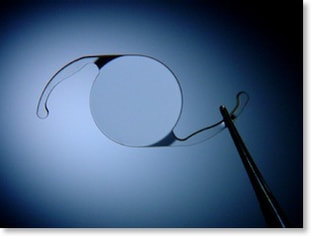"Cataracts are like gray hair: nearly everyone gets them as we get older."
-- M. Schermer
-- M. Schermer
|
It would make more sense to call it a "clouded natural lens", but over the years "cataract" has become the term. A cataract scatters light entering your eye, so that the light does not focus on a single point on the retina, and causes visual symptoms such as:
*blurred vision, even with best glasses *needing more light to read or see details *increased glare or halo around lights at night *"foggy" or "cloudy" vision *colors appearing yellowed or faded |

|
LenSx laser-assisted cataract surgery: LenSx® femtosecond laser makes a precise incision, which can reduce incision-related risks. The Procedure:
The surgeon makes a tiny incision in the eye, and removes the cataract with a method called phacoemulsification. It is a ultrasonic method, which has been reliably used for years. It is NOT a laser. However, recent advancements in technology have made it possible for the incision to be made by a laser, instead of by a blade. In both standard and laser-assisted surgeries, the cataract (crystalline lens) is removed and the IOL is put in place through the tiny incision. This incision generally heals within a few days, and usually does not need sutures. Follow Up Care: Cataract surgery is an out-patient procedure. You will be at the surgery center approximately three hours. Depending on your surgeon's preference, you may have an eye patch the first day or an eye shield when sleeping the first few weeks. Vigorous exercise and swimming may be limited for a few weeks. Many patients resume most normal activities, including driving, within a couple of days. You will need to use antibiotic and anti-inflammatory eye drops several times a day for the first month after surgery. Standard post-operative visits are at our office three weeks after your surgery. |
|
|
Contact Us
2620 Hurley Way Suite A Sacramento, CA 95864 Phone: 916-453-1111 info@lasereyes.com |
Office Hours
Mon 8:00 am - 5:30 pm Tue 8:00 am - 5:30 pm Wed 8:00 am - 5:30 pm Thu 8:00 am - 5:30 pm Fri 8:00 am - 5:30 pm |